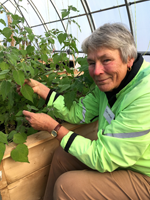We have all heard about the worrisome reduction in native bee and butterfly world-wide. But we can help a little on a local basis. BC is known to have about 400 different Native bees and many varieties of butterflies that depend on our Native plants.
By planting Native plants in your garden you will provide a food source suitable to those bees and butterflies (especially their caterpillars) and can enjoy the beauty of our local flora and fauna.

Dusky-blue berries of the Saskatoon bush (together with red thimble berries).
When the Saskatoon bush blooms in April-May they are covered in white flower, a great attraction to bees, then in July-August they have bluish-purple berries which are excellent food for many birds (not to forget for making delicious pies). And in between they nourish the caterpillars of pale tiger swallowtail, two-tailed swallowtail, and the western tiger swallowtail butterflies.
During the winter they provide browse for deer and elk. The Indigenous Nations in our area valued them to make dried berry cakes for winter food.
Saskatoons (Latin: Amemanchier alnifolia) also known as Serviceberry grow as a bush or small tree from 1-5 m tall and can be pruned to suit almost any garden space.
They are not fussy as to moisture growing well in dry or moist (but not wet environments) and even tolerate rocky slopes. They are happy in sun or dappled shade and provide a suitable environment for many under-story plants.
Saskatoon bush in full bloom
If you decide to plant one in your garden, go to a local nursery that specializes in Native plants. There are several on Vancouver Island (Bowser, Nanaimo, Victoria and Saltspring Island) and some of the general nurseries also have a section for Native plants.
But don’t rob the natural environment of its treasures.

Saskatoon bush in full bloom
Many plants are difficult to dig out having deep and/or widely spreading roots and hence are difficult to remove. Roots are likely to be damaged in the process and the plant will not survive.
When you are ready to plant your new arrival, take some care to get it happily situated. Fall is a great time, when the rains have started, but the soil is still warm for the roots to get established. Dig a hole: it should be noticeably larger than the pot the plant grew in.
Look at the roots as you take the plant out of the pot and cut off any damaged roots or roots that girdle other roots. Losing a few roots is better than a twisted mass. Spread out the roots and set it into your newly dug spot to the same level as the plant was in the original pot.
Fill with a mix of ½ good garden soil/ compost and ½ of the original soil. Water in thoroughly. If the season stays dry, water periodically until the plant is well established.
Enjoy many seasons of blossoms, bees, butterflies and birds (and pies).
 Dorothee Kieser
Dorothee Kieser
Certified Master Gardener
See all articles by Dorothee Kieser



